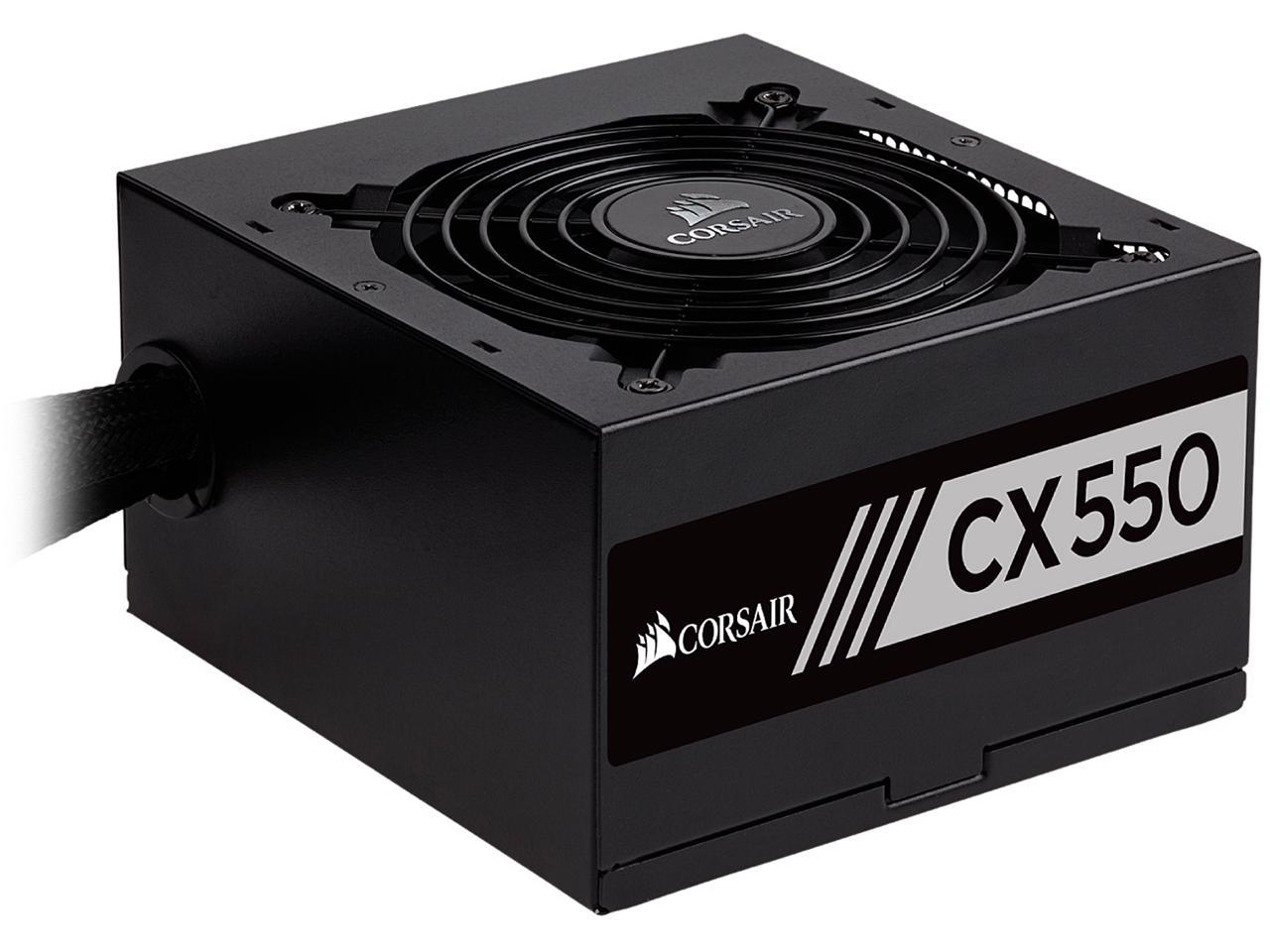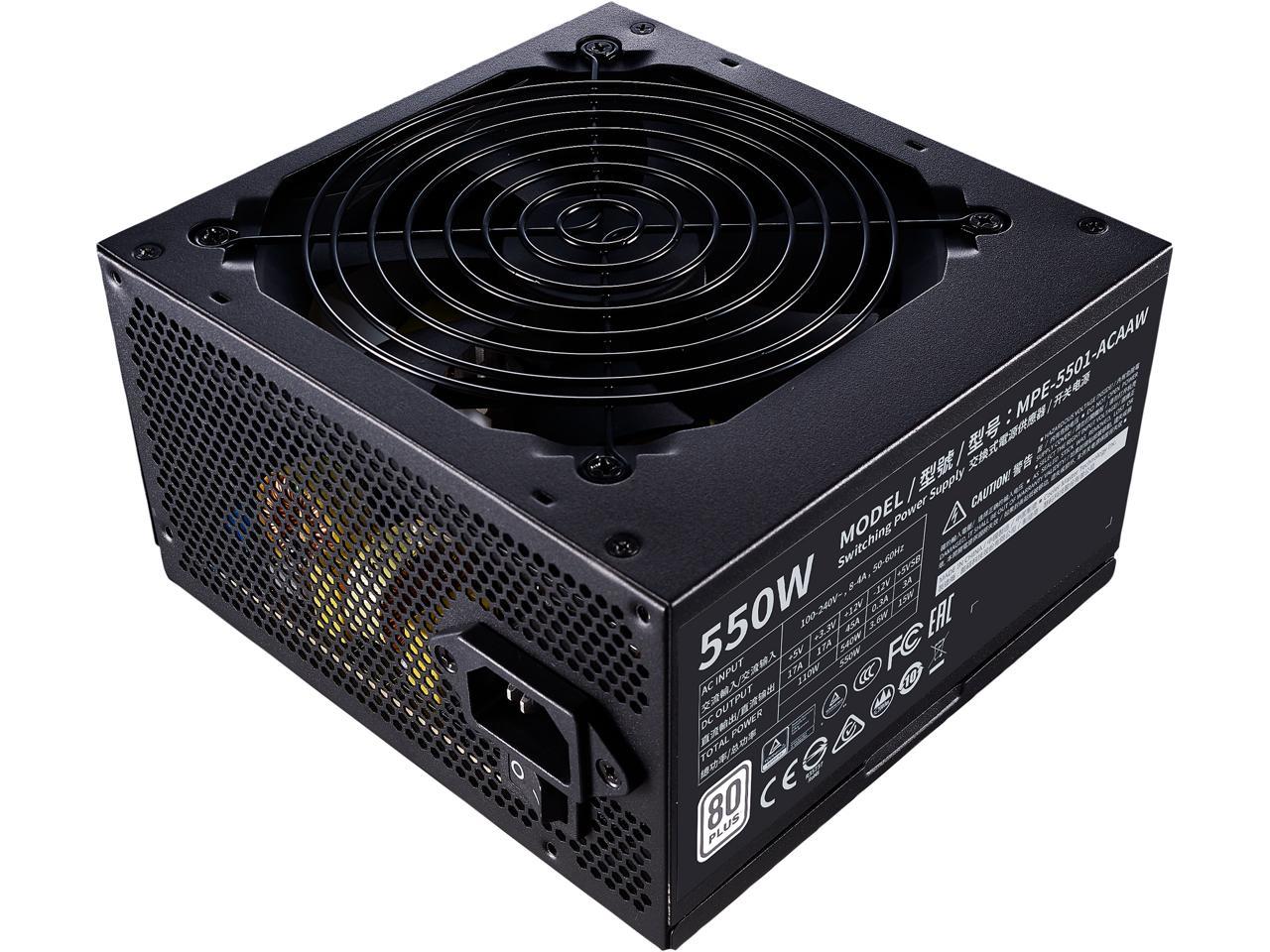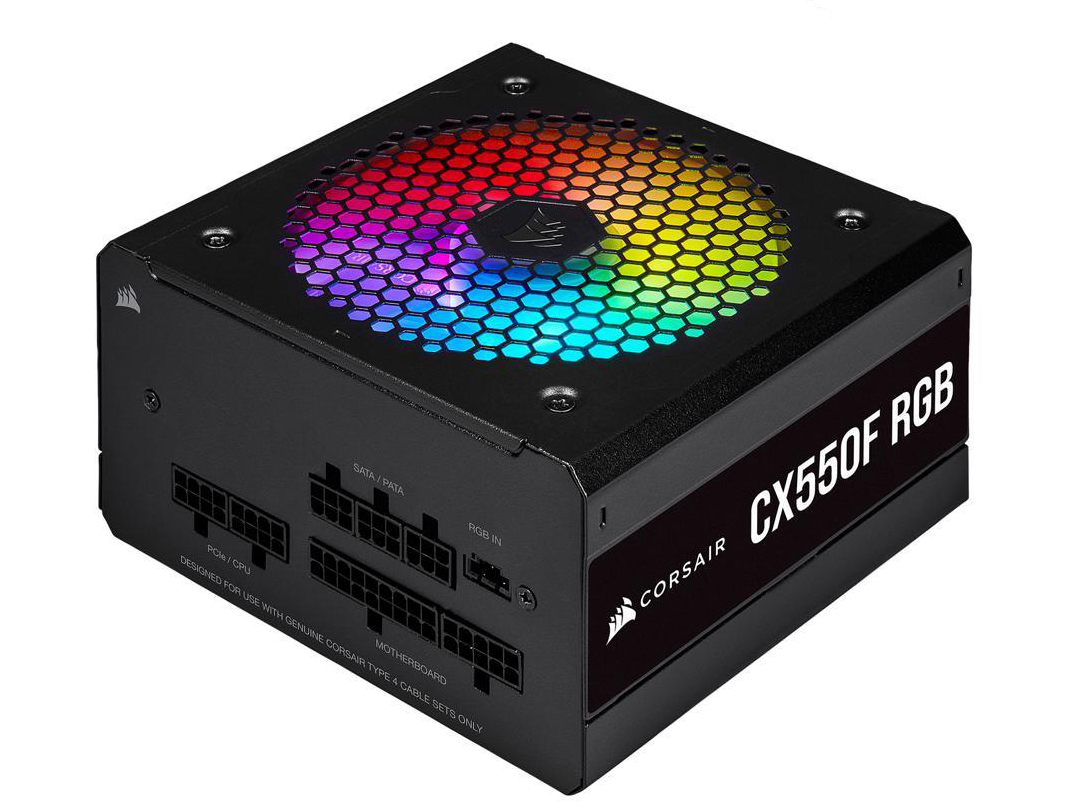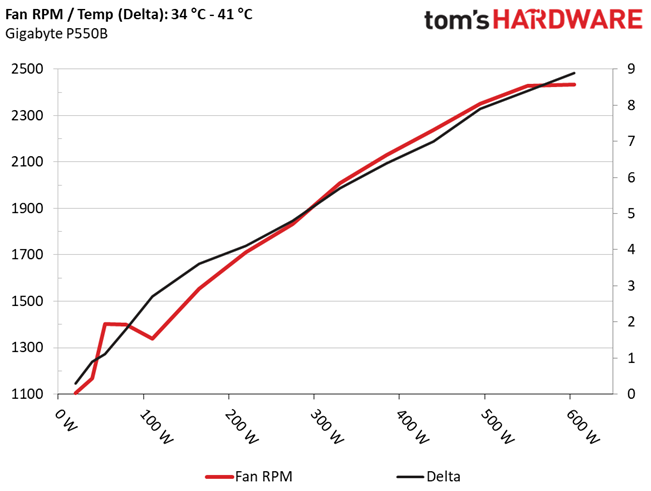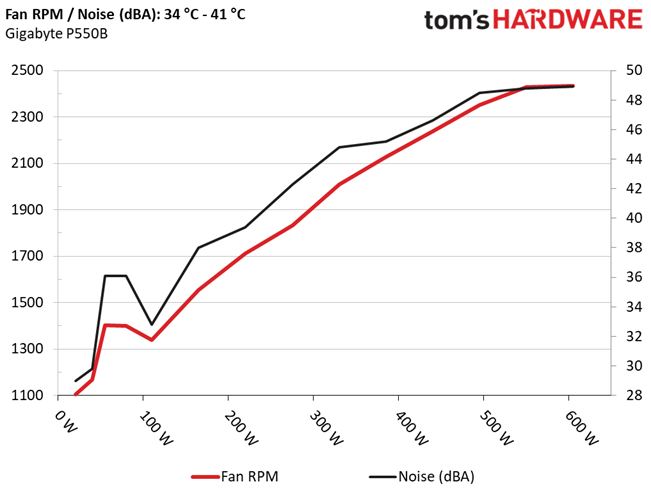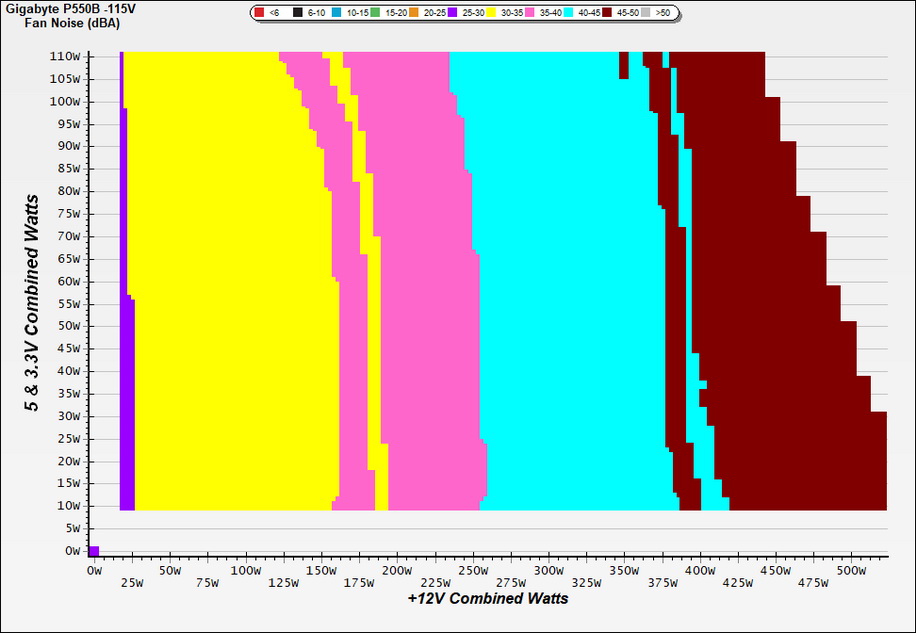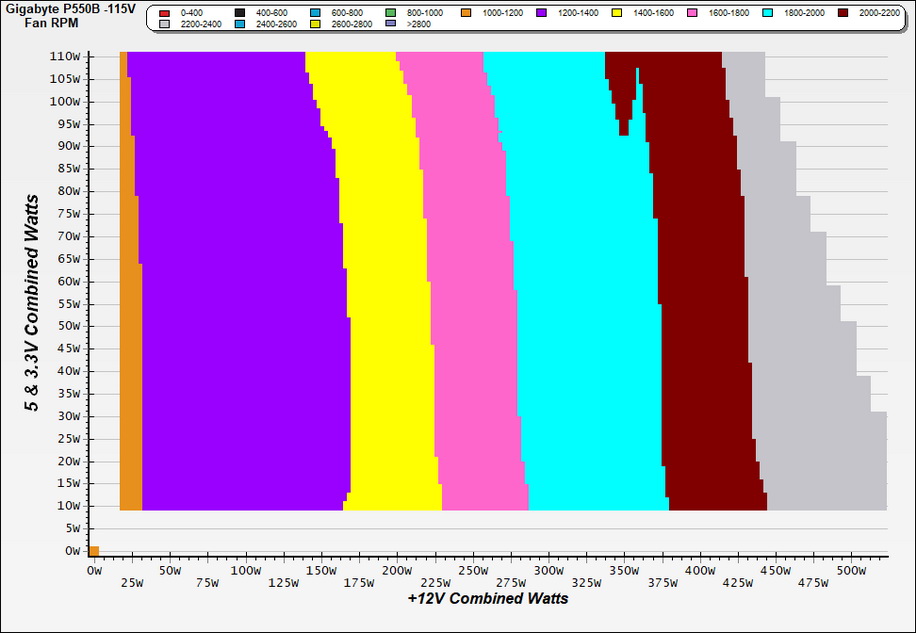Why you can trust Tom's Hardware
To learn more about our PSU tests and methodology, please check out How We Test Power Supply Units.
Primary Rails And 5VSB Load Regulation
The following charts show the main rails' voltage values recorded between a range of 40W up to the PSU's maximum specified load, along with the deviation (in percent). Tight regulation is an important consideration every time we review a power supply because it facilitates constant voltage levels despite varying loads. Tight load regulation also, among other factors, improves the system’s stability, especially under overclocked conditions and, at the same time, it applies less stress to the DC-DC converters that many system components utilize.
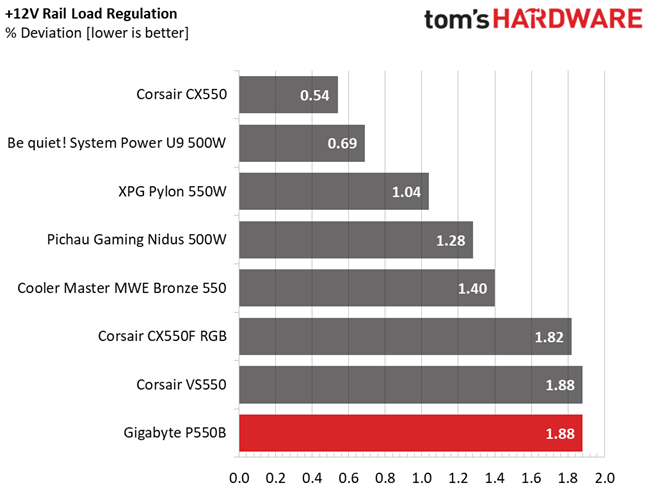
Results 1-8: Load Regulation
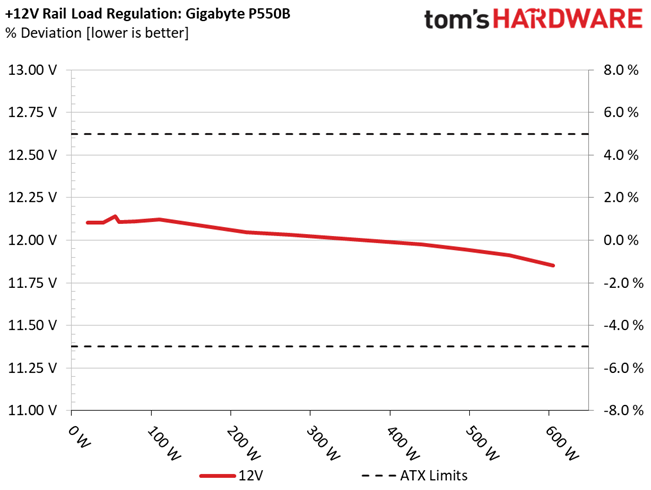
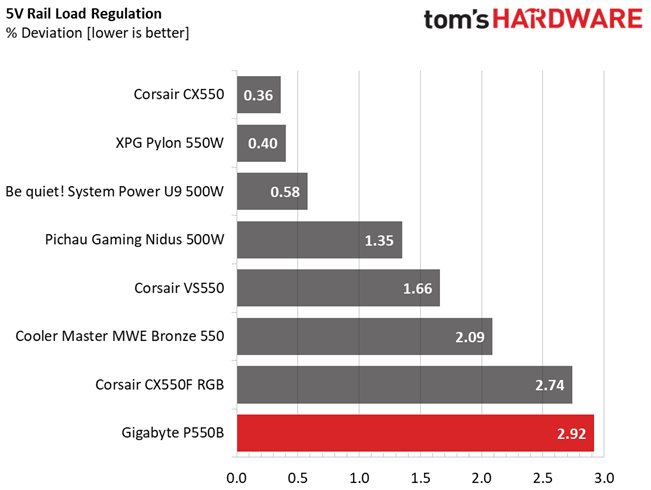
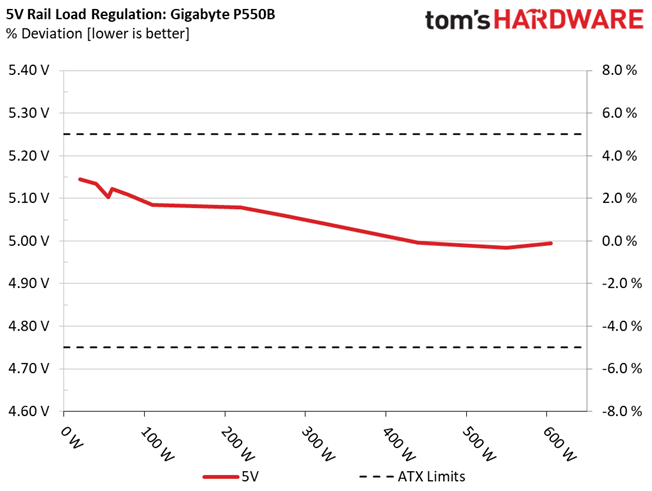
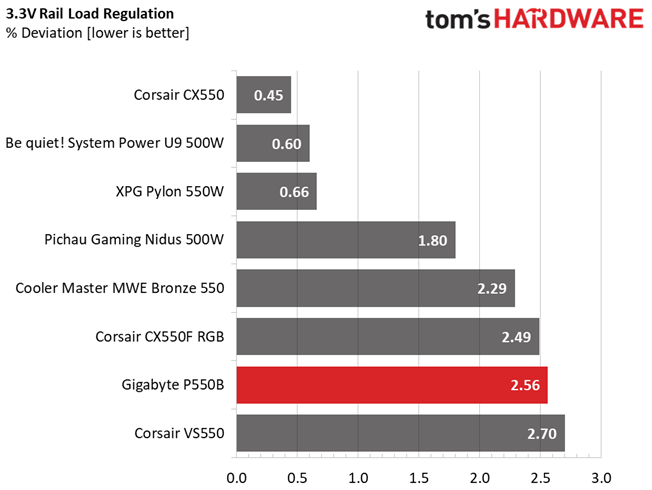
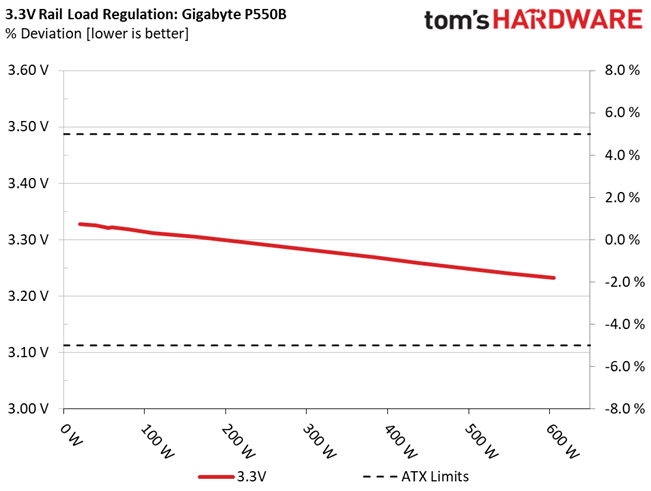


Load regulation is not tight on any of the PSU's rails.
Hold-Up Time
Put simply; hold-up time is the amount of time that the system can continue to run without shutting down or rebooting during a power interruption.
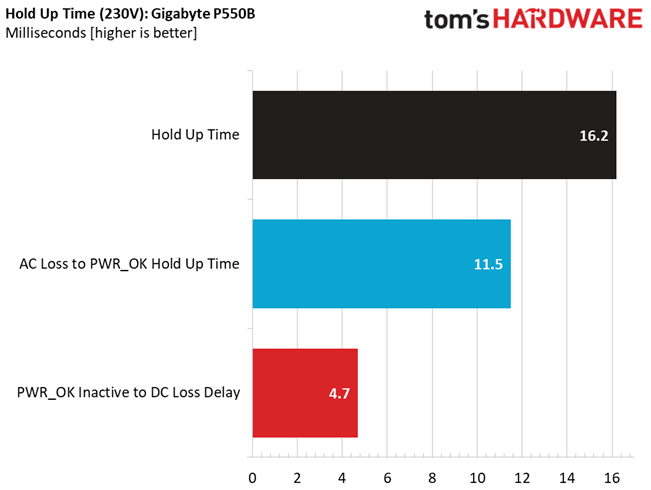
Results 9-12: Hold-Up Time
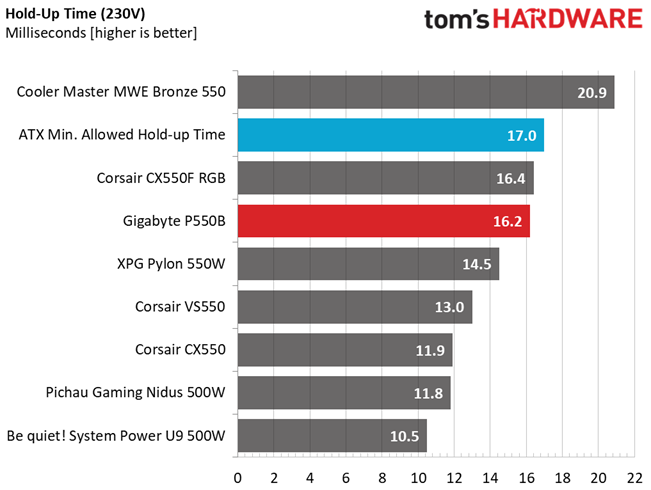
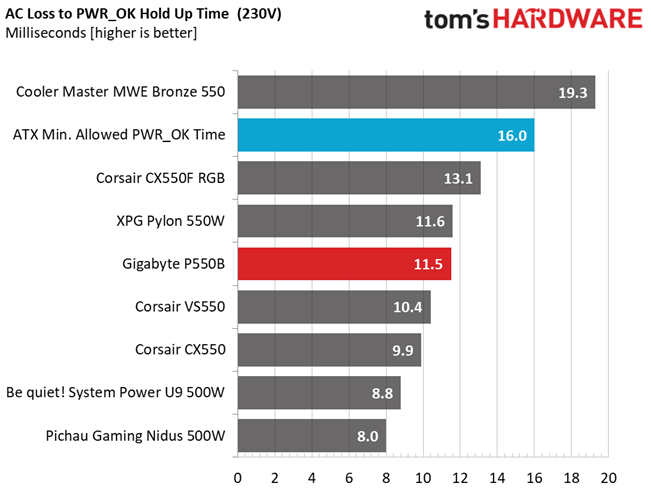
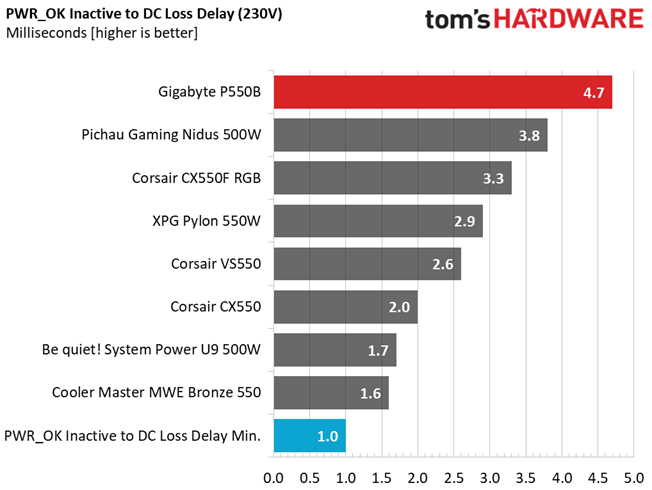
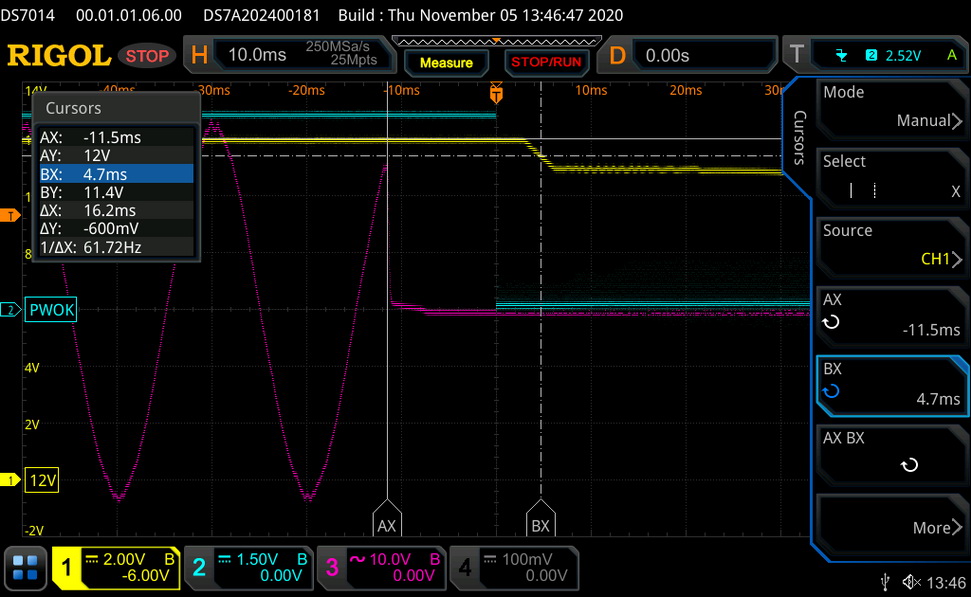
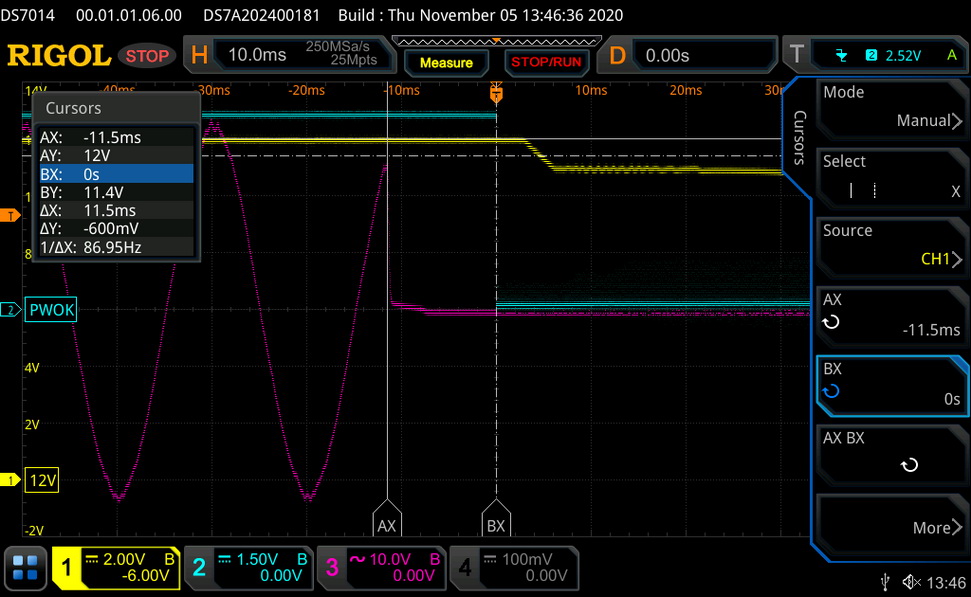
The hold-up time is not far away from 17ms, something that you don't easily see in this price range. On the other hand, the Power Ok signal's hold-up time is much lower than 16ms which is what the ATX spec requires.
Inrush Current
Inrush current, or switch-on surge, refers to the maximum, instantaneous input current drawn by an electrical device when it is first turned on. A large enough inrush current can cause circuit breakers and fuses to trip. It can also damage switches, relays, and bridge rectifiers. As a result, the lower the inrush current of a PSU right as it is turned on, the better.
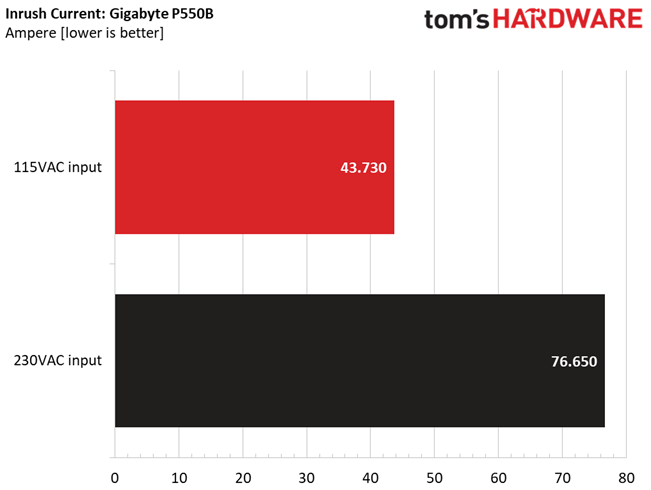
Results 13-14: Inrush Current
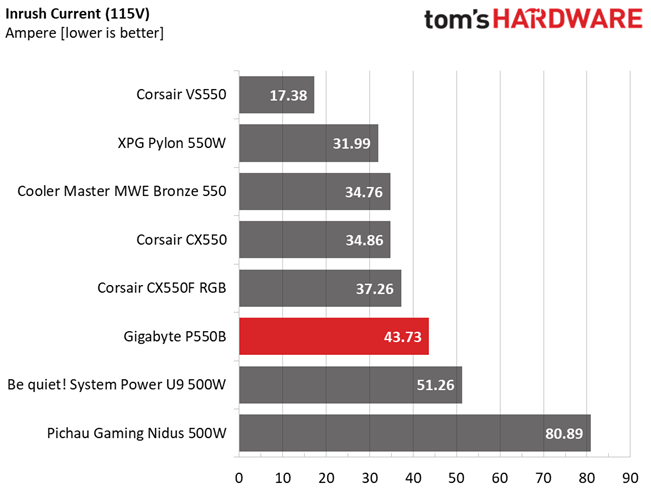
The inrush currents with both voltage inputs are not so high, but not low either.
Get Tom's Hardware's best news and in-depth reviews, straight to your inbox.
Leakage Current
In layman's terms, leakage current is the unwanted transfer of energy from one circuit to another. In power supplies, it is the current flowing from the primary side to the ground or the chassis, which in the majority of cases is connected to the ground. For measuring leakage current, we use a GW Instek GPT-9904 electrical safety tester instrument.
The leakage current test is conducted at 110% of the DUT's rated voltage input (so for a 230-240V device, we should conduct the test with 253-264V input). The maximum acceptable limit of a leakage current is 3.5 mA and it is defined by the IEC-60950-1 regulation, ensuring that the current is low and will not harm any person coming in contact with the power supply's chassis.
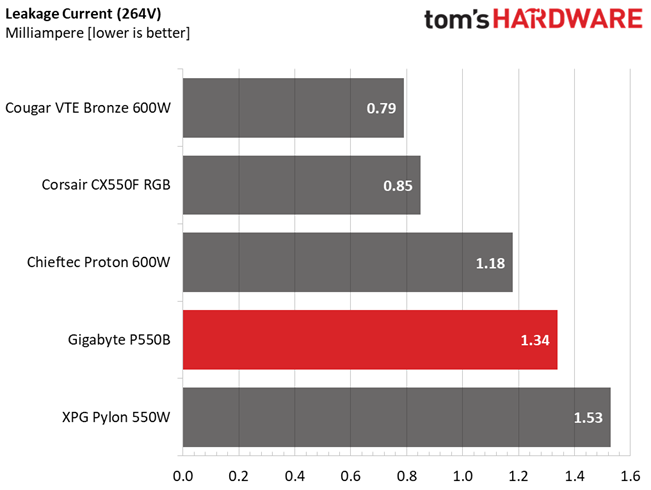
Low enough leakage current.
10-110% Load Tests
These tests reveal the PSU's load regulation and efficiency levels under high ambient temperatures. They also show how the fan speed profile behaves under increased operating temperatures.
| Test # | 12V | 5V | 3.3V | 5VSB | DC/AC (Watts) | Efficiency | Fan Speed (RPM) | PSU Noise (dB[A]) | Temps (In/Out) | PF/AC Volts |
| 1 | 2.748A | 1.960A | 1.988A | 0.982A | 54.966 | 77.695% | 1303 | 34.1 | 36.17°C | 0.830 |
| 12.140V | 5.102V | 3.321V | 5.094V | 70.746 | 38.39°C | 115.31V | ||||
| 2 | 6.528A | 2.951A | 2.988A | 1.182A | 110.034 | 83.675% | 1340 | 32.8 | 36.58°C | 0.950 |
| 12.122V | 5.084V | 3.312V | 5.078V | 131.502 | 39.24°C | 115.27V | ||||
| 3 | 10.674A | 3.444A | 3.496A | 1.383A | 165.033 | 85.389% | 1553 | 38.0 | 36.73°C | 0.984 |
| 12.083V | 5.082V | 3.305V | 5.063V | 193.272 | 40.35°C | 115.19V | ||||
| 4 | 14.844A | 3.939A | 4.005A | 1.585A | 220.043 | 85.669% | 1711 | 39.4 | 37.15°C | 0.996 |
| 12.048V | 5.078V | 3.296V | 5.048V | 256.853 | 41.27°C | 115.10V | ||||
| 5 | 18.659A | 4.941A | 5.021A | 1.789A | 275.044 | 85.413% | 1833 | 42.3 | 37.88°C | 0.993 |
| 12.034V | 5.059V | 3.287V | 5.031V | 322.018 | 42.68°C | 115.06V | ||||
| 6 | 22.494A | 5.957A | 6.044A | 1.995A | 330.041 | 84.927% | 2008 | 44.8 | 37.92°C | 0.991 |
| 12.013V | 5.038V | 3.277V | 5.014V | 388.616 | 43.58°C | 115.06V | ||||
| 7 | 26.346A | 6.979A | 7.071A | 2.202A | 385.119 | 84.221% | 2129 | 45.2 | 38.41°C | 0.990 |
| 11.994V | 5.017V | 3.268V | 4.997V | 457.273 | 44.78°C | 114.93V | ||||
| 8 | 30.208A | 8.003A | 8.105A | 2.410A | 440.192 | 83.382% | 2239 | 46.6 | 38.73°C | 0.991 |
| 11.977V | 4.996V | 3.258V | 4.980V | 527.919 | 45.73°C | 115.09V | ||||
| 9 | 34.515A | 8.519A | 8.617A | 2.414A | 494.756 | 82.495% | 2350 | 48.5 | 39.51°C | 0.992 |
| 11.944V | 4.990V | 3.249V | 4.972V | 599.737 | 47.36°C | 115.07V | ||||
| 10 | 38.637A | 9.032A | 9.168A | 3.038A | 549.972 | 81.434% | 2428 | 48.8 | 40.29°C | 0.992 |
| 11.912V | 4.984V | 3.240V | 4.940V | 675.359 | 48.65°C | 115.10V | ||||
| 11 | 43.489A | 9.013A | 9.191A | 3.042A | 605.194 | 80.304% | 2434 | 48.9 | 40.91°C | 0.992 |
| 11.853V | 4.994V | 3.232V | 4.932V | 753.625 | 49.79°C | 115.09V | ||||
| CL1 | 4.000A | 13.003A | 13.001A | 0.001A | 155.059 | 78.886% | 1885 | 42.2 | 37.30°C | 0.986 |
| 12.434V | 4.816V | 3.284V | 5.094V | 196.562 | 42.34°C | 115.20V | ||||
| CL2 | 43.524A | 1.000A | 1.002A | 0.001A | 512.010 | 82.401% | 2388 | 48.2 | 40.24°C | 0.993 |
| 11.568V | 5.247V | 3.266V | 5.076V | 621.364 | 48.78°C | 115.10V |
The PSU managed to handle the overload test without any issues, at an ambient temperature close to 41 degrees Celsius. It won't survive for prolonged use, though, under such tough conditions because of the low-quality caps that it uses, especially on its secondary side. The Chinese FETs on the APFC converter and the primary side do not look so promising, either.
20-80W Load Tests
In the following tests, we measure the PSU's efficiency at loads significantly lower than 10% of its maximum capacity (the lowest load the 80 PLUS standard measures). This is important for representing when a PC is idle with power-saving features turned on.
| Test # | 12V | 5V | 3.3V | 5VSB | DC/AC (Watts) | Efficiency | Fan Speed (RPM) | PSU Noise (dB[A]) | PF/AC Volts |
| 1 | 1.227A | 0.484A | 0.496A | 0.195A | 19.992 | 64.561% | 1105 | 29.0 | 0.571 |
| 12.103V | 5.144V | 3.328V | 5.128V | 30.966 | 115.32V | ||||
| 2 | 2.452A | 0.974A | 0.993A | 0.391A | 39.983 | 75.064% | 1169 | 29.8 | 0.748 |
| 12.104V | 5.134V | 3.325V | 5.119V | 53.265 | 115.32V | ||||
| 3 | 3.681A | 1.464A | 1.491A | 0.587A | 60.013 | 79.413% | 1401 | 36.1 | 0.846 |
| 12.106V | 5.122V | 3.322V | 5.109V | 75.571 | 115.31V | ||||
| 4 | 4.902A | 1.958A | 1.987A | 0.785A | 79.962 | 81.855% | 1399 | 36.1 | 0.902 |
| 12.110V | 5.109V | 3.318V | 5.098V | 97.687 | 115.29V |
The efficiency levels at light loads are disappointing, and the fan speed profile way too aggressive to keep the internals as cool as it gets to ensure a longer lifetime.
2% or 10W Load Test
Intel plans on raising the ante at efficiency levels under ultra-light loads. So from July 2020, the ATX spec will require 70% and higher efficiency with 115V input. The applied load is only 10W for PSUs with 500W and lower capacities, while for stronger units we dial 2% of their max-rated-capacity.
| Test # | 12V | 5V | 3.3V | 5VSB | DC/AC (Watts) | Efficiency | Fan Speed (RPM) | PSU Noise (dB[A]) | PF/AC Volts |
| 1 | 0.744A | 0.206A | 0.247A | 0.051A | 11.148 | 54.903% | 1098 | 28.5 | 0.455 |
| 12.098V | 5.153V | 3.330V | 5.135V | 20.305 | 115.31V |
Efficiency with 2% load is bottom low.
Efficiency & Power Factor
Next, we plotted a chart showing the PSU's efficiency at low loads, and loads from 10 to 110% of its maximum rated capacity. The higher a PSU’s efficiency, the less energy goes wasted, leading to a reduced carbon footprint and lower electricity bills. The same goes for Power Factor.
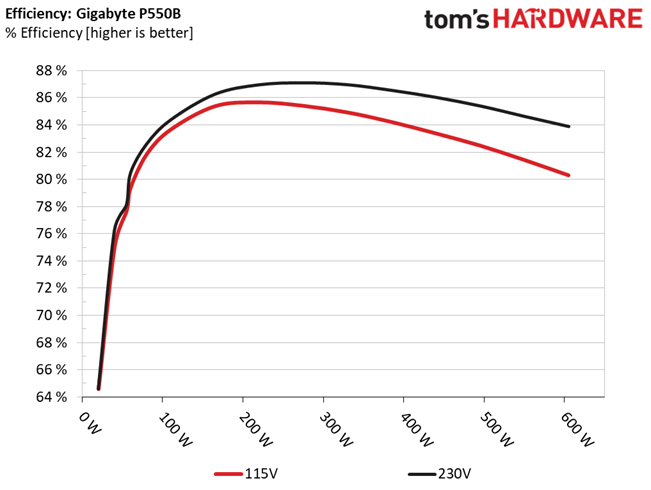
Results 15-18: Efficiency
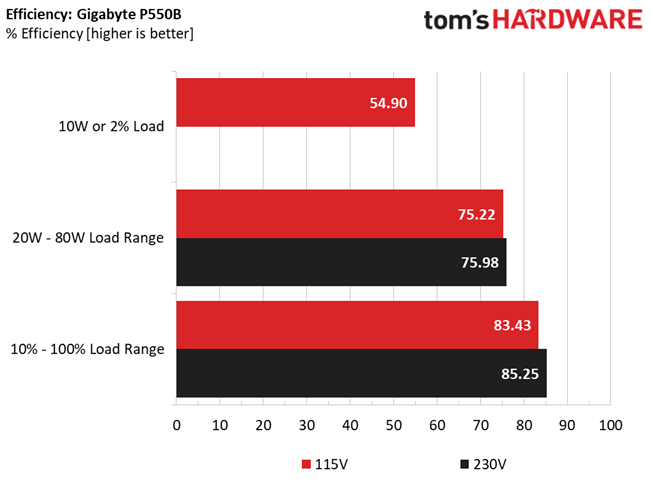
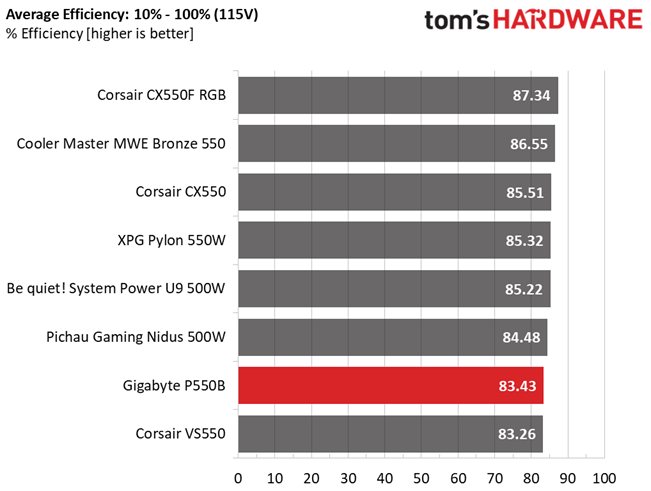
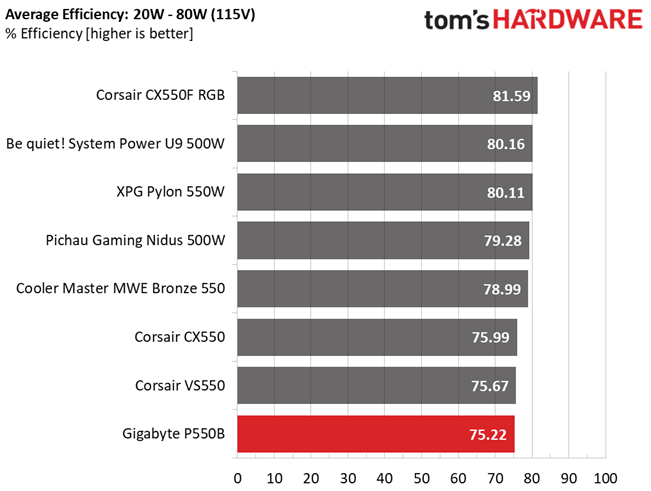
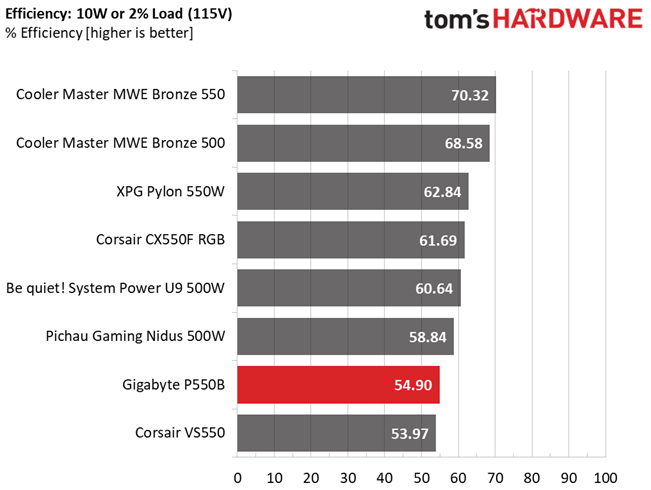
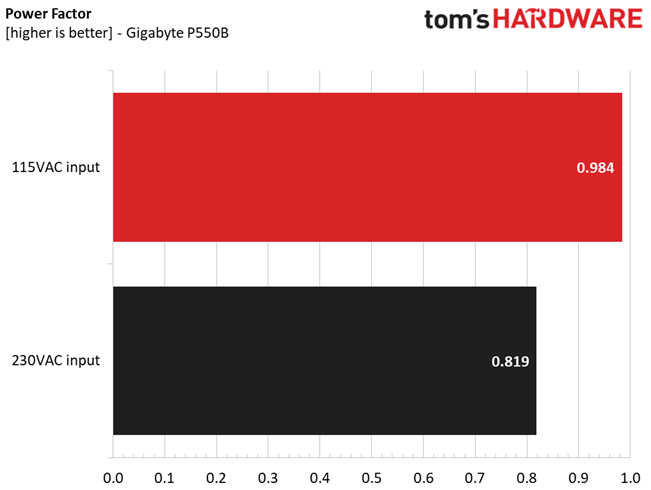
This is a low-efficiency platform, especially at light and super-light loads. To make matters worse, PF with 230V input is bottom low, showing that the APFC converter doesn't operate properly with this voltage input.
5VSB Efficiency
| Test # | 5VSB | DC/AC (Watts) | Efficiency | PF/AC Volts |
| 1 | 0.100A | 0.514 | 74.277% | 0.132 |
| 5.135V | 0.692 | 115.16V | ||
| 2 | 0.250A | 1.283 | 79.051% | 0.241 |
| 5.129V | 1.623 | 115.16V | ||
| 3 | 0.550A | 2.816 | 80.365% | 0.327 |
| 5.118V | 3.504 | 115.16V | ||
| 4 | 1.000A | 5.104 | 80.429% | 0.375 |
| 5.102V | 6.346 | 115.16V | ||
| 5 | 1.500A | 7.629 | 80.229% | 0.402 |
| 5.085V | 9.509 | 115.16V | ||
| 6 | 3.000A | 15.100 | 78.344% | 0.463 |
| 5.033V | 19.274 | 115.14V |
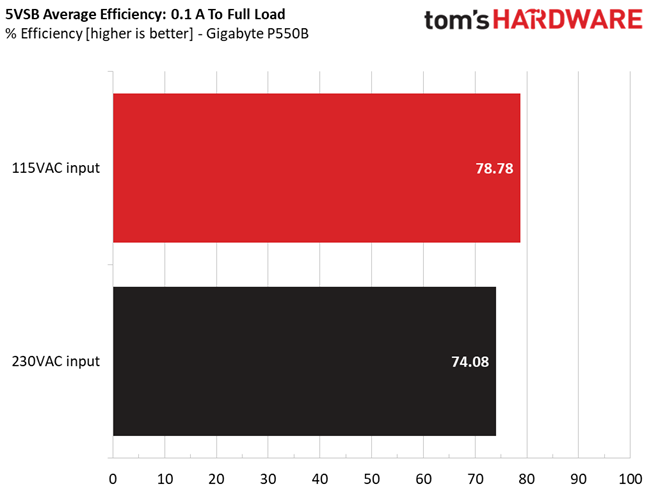
Results 19-20: 5VSB Efficiency
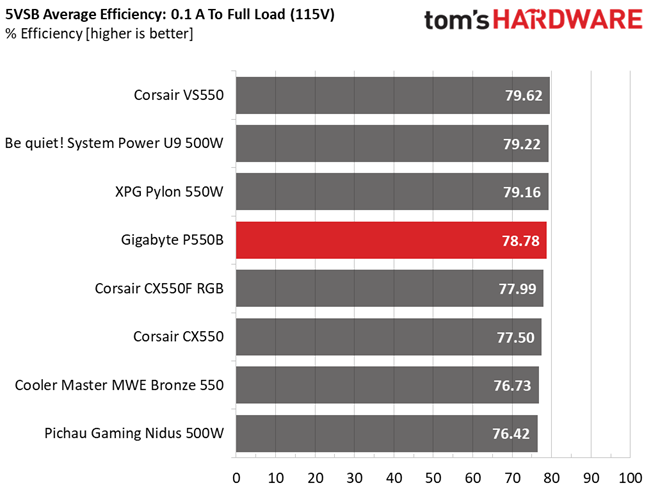
The 5VSB rail is efficient.
Power Consumption In Idle And Standby
| Mode | 12V | 5V | 3.3V | 5VSB | Watts | PF/AC Volts |
| Idle | 12.308V | 5.045V | 3.330V | 5.135V | 5.524 | 0.245 |
| 115.2V | ||||||
| Standby | 0.060 | 0.013 | ||||
| 115.2V |
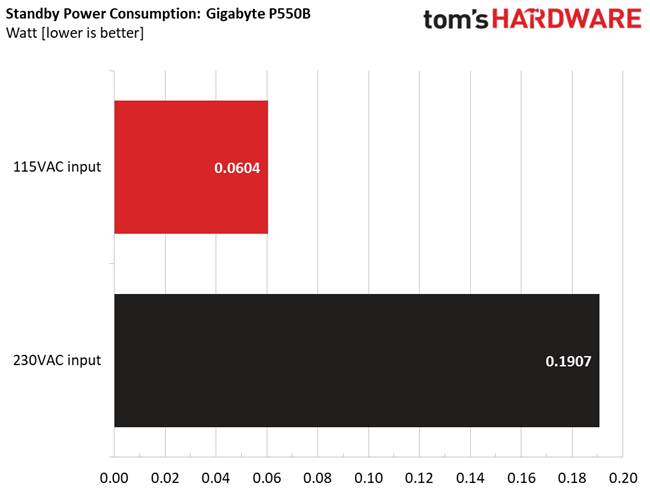
Results 21-22: Vampire Power
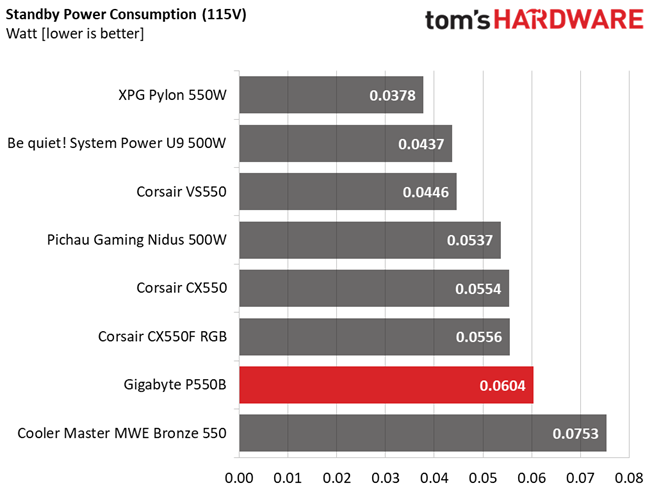
Vampire power is low with 115V, but quite high with 230V input.
Fan RPM, Delta Temperature, And Output Noise
All results are obtained between an ambient temperature of 37 to 47 degrees Celsius (98.6 to 116.6 degrees Fahrenheit).
Because of the small heat sinks, the fan has to spin at high speeds to keep the internal temperatures in control.
The following results were obtained at 30 to 32 degrees Celsius (86 to 89.6 degrees Fahrenheit) ambient temperature.
The fan starts at a high speed from light loads and exceeds 40 dBA noise with higher than 250W load. This is a very noisy power supply and you should keep this in mind, if you want to build a silent PC.
MORE: Best Power Supplies
MORE: How We Test Power Supplies
MORE: All Power Supply Content
Current page: Load Regulation, Hold-Up Time, Inrush & Leakage Current, Efficiency and Noise
Prev Page Specifications and Part Analysis Next Page Protection Features, DC Power Sequencing, Cross-Load Tests and Infrared Images
Aris Mpitziopoulos is a contributing editor at Tom's Hardware, covering PSUs.
-
refillable Nice one Aris! I have a request for you. Can you test the Seasonic S12III? It has been circulating around a year now and no one seems to be bothered testing it.Reply -
NightHawkRMX I second this request for the S12iii. Given the popularity of the S12ii (at least back in the day), I am interested to see a review of the successor. I think the fact its RSY made kind of adds to my interest.Reply -
NightHawkRMX Gigabyte GP-P750GM 750 W Review - With an Explosive Attitude | TechPowerUpReply
Well, at least it did not explode.
Gigabyte should just be banned from making PSUs at this point. -
Aris_Mp Reply
Yes this one didn't treat me with fireworks :)NightHawkRMX said:Gigabyte GP-P750GM 750 W Review - With an Explosive Attitude | TechPowerUpWell, at least it did not explode.
Gigabyte should just be banned from making PSUs at this point.
